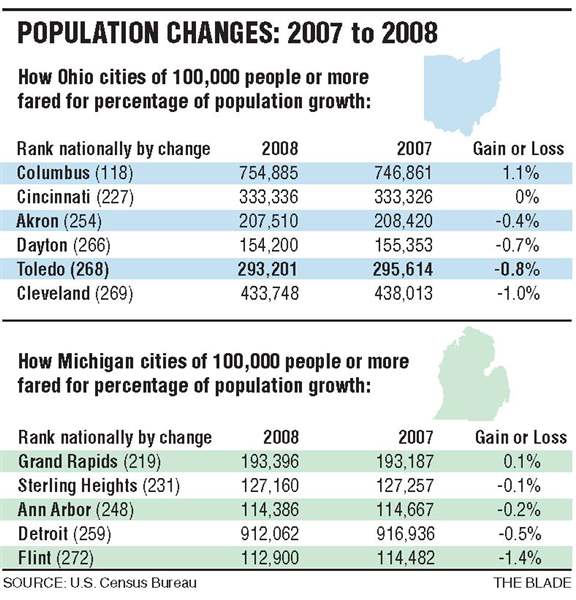
Toledo loses 2,413 residents or 0.8% of population in year
7/1/2009
For Toledo to race back to prosperity, it'll have to do so as a tortoise and not a hare.
New U.S. Census Bureau estimates being released today show Toledo was America's 268th slowest-growing city of 100,000 or more residents between July 1, 2007 and July 1, 2008.
Toledo had a net loss of 0.8 percent residents, going from 295,614 residents on July 1, 2007 to 293,201 a year later, according to figures that local officials were quick to dispute Tuesday.
Among them was Mayor Carty Finkbeiner, who led a successful drive to get last summer's 2007 estimate readjusted upward by 21,822 people. It was not reflected in today's report, prompting Mr. Finkbeiner to say he doesn't "put a whole heck of a lot of stock" in this new study, either.
But as Greg Harper, a Census Bureau demographer noted last March, the additional 21,822 won't be enough to undo Toledo's underlying trend once the figures are entered. Once adjusted, the city's population should be changed retroactively to 316,851 as of July 1, 2007, officials have said.
The top spot in the latest survey was held by New Orleans, which experienced an 8.2 percent increase in growth between 2007 and 2008 as the Crescent City restocks itself in the aftermath of Hurricane Katrina.
The bottom spot was No. 273 held by Baton Rouge, La., where many refugees from that historic 2005 hurricane had temporarily emigrated. Baton Rouge had a 1.4 percent population loss.

The Michigan-Ohio region at large fared little better than Toledo itself: Only Columbus, which came in 118th, was in the upper half for growth. Cleveland and Flint both lost a larger percentage of their populations than Toledo.
And across the upper Midwest, Rochester, Minn., and Madison, Wis., were the only two cities north of Toledo to post one-year gains of 1.4 percent or greater.
Forty-three of the 100 fastest-growing cities of 100,000 people or more were in California (23) or Texas (20), with the vast majority of others also in warm climates.
Ordinarily, being fifth from the bottom might sound like time to panic.
But Calvin Lawshe said people should keep a cool head.
Mr. Lawshe, director of the Toledo-Lucas County Plan Commissions, said Toledo was not alone in taking on the Census Bureau.
Cincinnati, Detroit, and other large metro areas challenged the bureau and won, too.
So why fuss over whether a city's population is incrementally expanding or gradually eroding?
One reason: money.
Communities that appear to be stagnant or losing population aren't as attractive to businesses and industry. Developers may perceive them as dead-end investments with less hope for growth because of their housing glut. Many have higher taxes to make up for their loss of services.
In short, there's more at stake than meets the eye whenever the Census Bureau tweaks, adjusts, and publishes new estimates in-between its official population counts that occur once every 10 years.
"If a community is not showing any growth, why would [an investor] want to look at it?" Mr. Lawshe, a co-chairman of Toledo's 2010 Everyone Counts Committee, said.
He said he wants to "be able to sell my city as one of stability and growth."
Population figures and trending data are used by the government to determine how much money cities are eligible to receive in the form of community development block grants. Those are federal grants that communities use to subsidize housing, jobs, and a variety of services in low- and moderate-income neighborhoods.
Toledo just learned from the U.S. Department of Housing and Urban Development that it will have to make do with $7.7 million in such grant money for the next fiscal year, a decrease of $293,585 from what it would have had if the population figured had not been readjusted upward.
A HUD official said the city's allocation was being reduced because its "growth lag is less."
Staff writer Tom Troy contributed to this report.
Contact Tom Henry at:
thenry@theblade.com
or 419-724-6079.